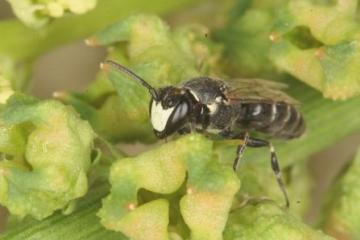Species Account for Hylaeus signatus
Hylaeus signatus (Panzer, 1798)
Large Yellow-faced Bee
Aculeata: Colletinae

Reproduction for study and non-profit use permitted, all other rights reserved.
Taxonomic group: bees and wasps (Aculeata) - County data
View time series maps for Hylaeus signatus
member log-on for taxon report
Status: Nb
Essex RDB: Listed
Threat: Regionally Important
Images
upload a new image
Essex Red Data List comment
forages on Reseda
Species text
This bee is mainly recorded from southern England, with about 30 known post-1970 sites known to Falk (1991a), over half in Kent. In Essex the bee is mainly found near the Thames in post-industrial habitats and disused mineral extraction sites where Weld Reseda luteola or Mignonette Reseda lutea occur. There is a close association with Reseda, from which the bee collects pollen to provision its cells. Falk (at a lecture in 2003) stated that in Warwickshire the species does not occur in isolated parts of the county even where good stands of Reseda occur - indicating the importance of a continuity of habitat mosaic and the nature conservation losses that occur when fragmentation becomes excessive, currently a massive threat in the East Thames Corridor. Nests have been recorded from dead woody stems of bramble and rose, in hard clay banks and occasionally in the mortar of masonry. References
Habitats
Recorded management for locations with Hylaeus signatus
Recorded substrate and hydrology for locations with Hylaeus signatus
Why not join the Club, register and add a new species page
Interpretation of distribution maps



















